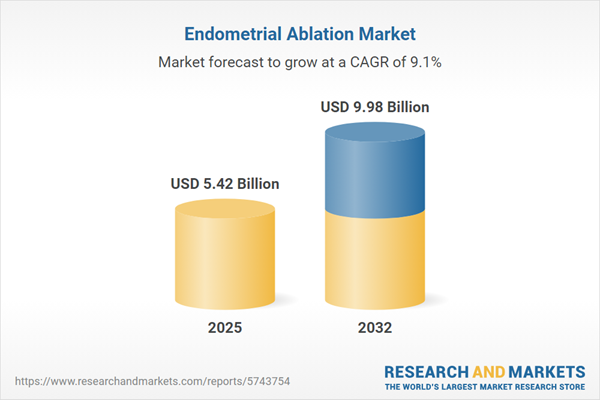Speak directly to the analyst to clarify any post sales queries you may have.
The endometrial ablation market is transforming gynecological care by delivering less invasive alternatives and operational efficiency, making it a focal point for healthcare leaders focused on long-term performance and evolving clinical demands.
Market Snapshot: Endometrial Ablation Market Size and Growth
The global endometrial ablation market expanded from USD 4.95 billion in 2024 to USD 5.42 billion in 2025, reflecting a 9.14% CAGR. By 2032, the market is expected to approach USD 9.98 billion. This robust growth underscores broader acceptance of endometrial ablation, ongoing advancements in device technology, and the industry’s pursuit of cost-effective solutions. Improved device accuracy and efficiency, coupled with advanced procedural techniques, enable organizations to meet new clinical and administrative demands. Healthcare systems benefit from these changes as they align with the priority to streamline services while navigating shifting policies and evolving care models.
Scope & Segmentation: Insights into the Endometrial Ablation Market
This comprehensive report provides senior decision-makers with actionable intelligence across all critical segments, supporting strategic investment and targeted operational planning. Segment-specific analysis helps organizations address unique clinical, regulatory, and commercial priorities:
- Distribution Channel: Examines direct sales tactics and distributor alliances, revealing how product access and clinical training strategies influence competitive positioning.
- Procedure Approach: Details both hysteroscopic and nonhysteroscopic procedures, allowing organizations to address varied healthcare settings and patient preferences.
- Application: Assesses uses such as management of endometrial hyperplasia, fibroids, heavy menstrual bleeding, and polyp elimination, showing broad relevance for women’s health initiatives.
- End User: Analyzes the roles of ambulatory surgical centers, clinics, and hospitals, clarifying how adoption trends shape local care complexities and operational efficiency.
- Technology: Reviews cryoablation, hydrothermal, microwave, radiofrequency, and thermal balloon systems, reflecting adaptation to specific clinical precision and patient outcome requirements.
- Age Group: Segments patient outreach strategies for those aged 35–44, 45–54, 55–64, and above 64, supporting precision in outreach and tailored clinical solutions.
- Regions: Maps the Americas, Europe, Asia-Pacific, and Middle East & Africa, helping leaders navigate diverse regulatory landscapes, demographic profiles, and logistical factors.
- Companies: Tracks leading companies and their strategic initiatives, highlighting innovation models, partner development, and approaches to market dynamics.
Key Takeaways for Healthcare Decision-Makers
- Minimally invasive ablation solutions are shifting gynecological workflows, supporting clinician adoption and meeting heightened patient demand for less disruptive treatments.
- Integrating advanced imaging and device technologies enables organizations to deliver higher procedural accuracy, streamline surgical throughput, and optimize outpatient scheduling.
- Digital health tools—including telemonitoring and enhanced patient education—are strengthening perioperative processes and ongoing patient engagement, driving higher value in care delivery.
- Strategic mergers and innovative business models are broadening product lines while embedding analytics into core systems, streamlining care and improving operational agility.
- Supply chain modernization, including localized procurement and risk-reduction tactics, is central to maintaining reliable equipment access amid shifting global trade dynamics.
- Adapted market-entry and commercialization approaches foster stronger regulatory alignment and support sustainable, localized presence across diverse international settings.
Tariff Impact: Navigating 2025 Supply Chain and Pricing Dynamics
Upcoming changes to U.S. tariffs are expected to reshape procurement and sourcing for endometrial ablation devices in 2025. Industry players are prioritizing domestic agreements and revising supplier networks to mitigate external risks. As organizations adapt to evolving cost and supply structures, procurement teams should reexamine procedural alternatives and adjust sourcing priorities to maintain consistent performance and minimize disruption.
Methodology & Data Sources
This research integrates findings from peer-reviewed publications, regulatory disclosures, clinical trials, and insights from industry leaders. Proprietary analytics are matched with third-party validation to ensure high credibility and robust executive planning value.
Why This Report Matters
- Delivers detailed segmentation to align technology deployment, supply chain strategy, and operations with the changing landscape of endometrial ablation.
- Enables confident strategic decisions by mapping evolving frameworks, market structures, and regulatory shifts within the industry.
- Supports proactive risk management, informed market entry, and tailored operational execution in a competitive sector.
Conclusion
Well-informed insights into the endometrial ablation market empower healthcare organizations to identify timely opportunities and optimize resource allocation. Strategic research supports resilience and sustainable advancement amid a rapidly changing clinical environment.
Additional Product Information:
- Purchase of this report includes 1 year online access with quarterly updates.
- This report can be updated on request. Please contact our Customer Experience team using the Ask a Question widget on our website.
Table of Contents
3. Executive Summary
4. Market Overview
7. Cumulative Impact of Artificial Intelligence 2025
List of Figures
Samples

LOADING...
Companies Mentioned
The key companies profiled in this Endometrial Ablation market report include:- Hologic, Inc.
- Olympus Corporation
- Medtronic plc
- CooperSurgical, Inc.
- Boston Scientific Corporation
- Smith & Nephew plc
- GE HealthCare Technologies Inc.
- Stryker Corporation
- Becton, Dickinson and Company
- B. Braun Melsungen AG
Table Information
| Report Attribute | Details |
|---|---|
| No. of Pages | 197 |
| Published | October 2025 |
| Forecast Period | 2025 - 2032 |
| Estimated Market Value ( USD | $ 5.42 Billion |
| Forecasted Market Value ( USD | $ 9.98 Billion |
| Compound Annual Growth Rate | 9.1% |
| Regions Covered | Global |
| No. of Companies Mentioned | 11 |









